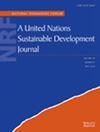Assessing the nonlinear impact of population aging on energy footprint: From the perspective of labor productivity and high‐quality economic development
IF 3.7
4区 社会学
Q2 ENVIRONMENTAL SCIENCES
引用次数: 0
Abstract
Amidst the ongoing low‐carbon transition, the phenomenon of population aging is receiving increasing attention. Nevertheless, the relationship between population aging and environmental quality has not been conclusively established, and existing studies have yet to delve into the mechanism of the effect of population aging on energy and environmental quality. This paper utilizes the panel data of 30 Chinese provinces and regions from 2000 to 2019 and constructs the benchmark model, the nonlinear mediating effect, and the nonlinear moderating effect models to explore the nonlinear association between population aging and energy footprint, respectively. Additionally, we develop a comprehensive aging index employing principal component analysis (PCA) and measure the energy footprint by carbon sink approach. The results show that population aging has a nonlinear effect on the energy footprint with an inverted “U” shape and there is an inflection point on the curve of value 0.453. We also verify that population aging indirectly affects the energy footprint through its nonlinear impact on labor productivity, with an instantaneous mediating effect of 3.0902. Furthermore, the high‐quality economic development has a nonlinear moderating impact on the inverted “U”‐shape between population aging and energy footprint. As the level of high‐quality economic development increases, the shape of the inverted “U” curve flattens out, and the inflection point shifts to the left. Among the five sub‐indicators of high‐quality economic development, green development has the most significant effect on the inverted “U” curve of population aging and energy footprint. These noteworthy findings offer valuable insights for formulating effective strategies to enhance the favorable effects of aging on environmental quality from multifaceted perspectives.评估人口老龄化对能源足迹的非线性影响:从劳动生产率和经济高质量发展的角度出发
在低碳转型的大背景下,人口老龄化现象日益受到关注。然而,人口老龄化与环境质量之间的关系尚未得到定论,现有研究也尚未深入探讨人口老龄化对能源环境质量的影响机制。本文利用 2000 年至 2019 年中国 30 个省区的面板数据,分别构建了基准模型、非线性中介效应模型和非线性调节效应模型,探讨人口老龄化与能源足迹之间的非线性关联。此外,我们还利用主成分分析法(PCA)建立了综合老龄化指数,并采用碳汇方法测量了能源足迹。结果表明,人口老龄化对能源足迹有非线性影响,呈倒 "U "形,且曲线上有一个拐点,拐点值为 0.453。我们还验证了人口老龄化通过对劳动生产率的非线性影响间接影响能源足迹,其瞬时中介效应为 3.0902。此外,高质量的经济发展对人口老龄化与能源足迹之间的倒 "U "型曲线具有非线性调节作用。随着高质量经济发展水平的提高,倒 "U "型曲线的形状趋于平缓,拐点向左移动。在高质量经济发展的五个子指标中,绿色发展对人口老龄化和能源足迹的倒 "U "型曲线的影响最为显著。这些值得关注的发现为从多角度制定有效战略,增强老龄化对环境质量的有利影响提供了宝贵的启示。
本文章由计算机程序翻译,如有差异,请以英文原文为准。
求助全文
约1分钟内获得全文
求助全文
来源期刊

Natural Resources Forum
环境科学-环境科学
CiteScore
6.10
自引率
0.00%
发文量
24
审稿时长
>36 weeks
期刊介绍:
Natural Resources Forum, a United Nations Sustainable Development Journal, focuses on international, multidisciplinary issues related to sustainable development, with an emphasis on developing countries. The journal seeks to address gaps in current knowledge and stimulate policy discussions on the most critical issues associated with the sustainable development agenda, by promoting research that integrates the social, economic, and environmental dimensions of sustainable development. Contributions that inform the global policy debate through pragmatic lessons learned from experience at the local, national, and global levels are encouraged.
The Journal considers articles written on all topics relevant to sustainable development. In addition, it dedicates series, issues and special sections to specific themes that are relevant to the current discussions of the United Nations Commission on Sustainable Development (CSD). Articles must be based on original research and must be relevant to policy-making.
Criteria for selection of submitted articles include:
1) Relevance and importance of the topic discussed to sustainable development in general, both in terms of policy impacts and gaps in current knowledge being addressed by the article;
2) Treatment of the topic that incorporates social, economic and environmental aspects of sustainable development, rather than focusing purely on sectoral and/or technical aspects;
3) Articles must contain original applied material drawn from concrete projects, policy implementation, or literature reviews; purely theoretical papers are not entertained.
 求助内容:
求助内容: 应助结果提醒方式:
应助结果提醒方式:


